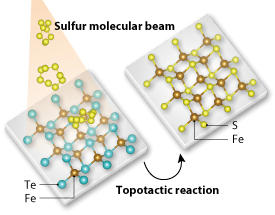

12/23/2019

Reproduced from Ref. 1, with permission from PNAS © 2019
Flying in the face of expectations, the high-temperature superconductivity of a single-atomic layer of iron selenide on strontium titanate cannot be explained solely by coupling between electrons and sound waves, experimentalists at AIMR have shown1. This finding will force material scientists to re-evaluate the origin of the system’s superconductivity.
The system consisting of a monolayer of iron selenide (FeSe) on a strontium titanate (SrTiO3) substrate caused a stir in 2012 when it was found to superconduct at the high temperature of 65 kelvin, making it the iron-based superconductor with the highest transition temperature.
It is also anomalous in that almost all high-temperature superconductors lose their high-temperature superconductivity when they are made into monolayer films, whereas the transition temperature of iron selenide actually increases from 8 kelvin for a block of the material to 65 kelvin for a single-atom layer.
There has been a lot of discussion about what is responsible for the superconductivity of monolayer iron selenide on strontium titanate. A popular explanation is that coupling between electrons in the monolayer and sound waves (phonons) in the substrate alone generates the superconductivity.
Now, by performing measurements on a sister system to iron selenide, Takafumi Sato at the AIMR at Tohoku University, Kosuke Nakayama at Tohoku University, and their co-workers, have demonstrated that this mechanism can be ruled out. They did this by growing a single-atom film of iron sulphide (FeS) on strontium titanate and revealing that, while it had the same crystal structure as iron selenide and strong electron–phonon coupling, it did not exhibit high-temperature superconductivity.
This finding came as a surprise to the team. “We were so sure that electron–phonon coupling was essential for high-temperature superconductivity in iron selenide that when we observed it in monolayer iron sulphide we felt almost certain that we had made a new high-temperature superconductor,” recalls Sato. He notes that while the measurement shows that electron–phonon coupling is not solely responsible for the superconductivity, the coupling may still contribute to it.
Until now no-one had succeeded in growing a monolayer of iron sulphide. To achieve that, the team developed a new fabrication method that involved first depositing sulfur atoms on a monolayer of iron telluride (see image). They then induced a reaction that effectively swapped the tellurium atoms with sulfur atoms. This fabrication method is promising for making other novel functional materials such as metal dichalcogenides and topological systems.
The team suspects that strong correlations between electrons in the iron selenide monolayer may be responsible for its superconductivity, and they are now doing experiments to test this hunch.
This research highlight has been approved by the authors of the original article and all information and data contained within has been provided by said authors.